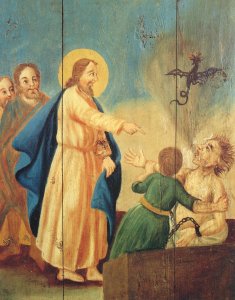|
Lutherische Kirch in Krummenau Photographie Max Galli 
German Epilepsy Museum Kork www.epilepsiemuseum.de |
Im Hunsrück gibt es eine Reihe kleiner Barock-Kirchen, die lutherisch geprägt sind: nüchterne Innenarchitektur und Ausstattung sowie spärliche Ausmalung, oft von anrührender Naivität. Mitunter sind Bilder aus dem Leben Jesu in bäuerlicher Manier und mit kräftigen Farben auf die Füllbretter der Emporenbrüstung gemalt. Den Bildern liegt meist ein wohldurchdachtes, erzieherisch-theologisches Programm zu Grunde, das den meist leseunkundigen Gläubigen den Inhalt der Bibel und ihren Sinngehalt nahe bringen sollte. Es ist nicht sicher, ob die Tafelbilder der Kirche in Krummenau aus der Werkstatt des Johann Georg Engisch stammen, der auch die Bilder der lutherischen Kirche im benachbarten Dill schuf. |



